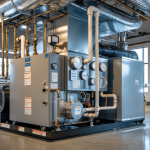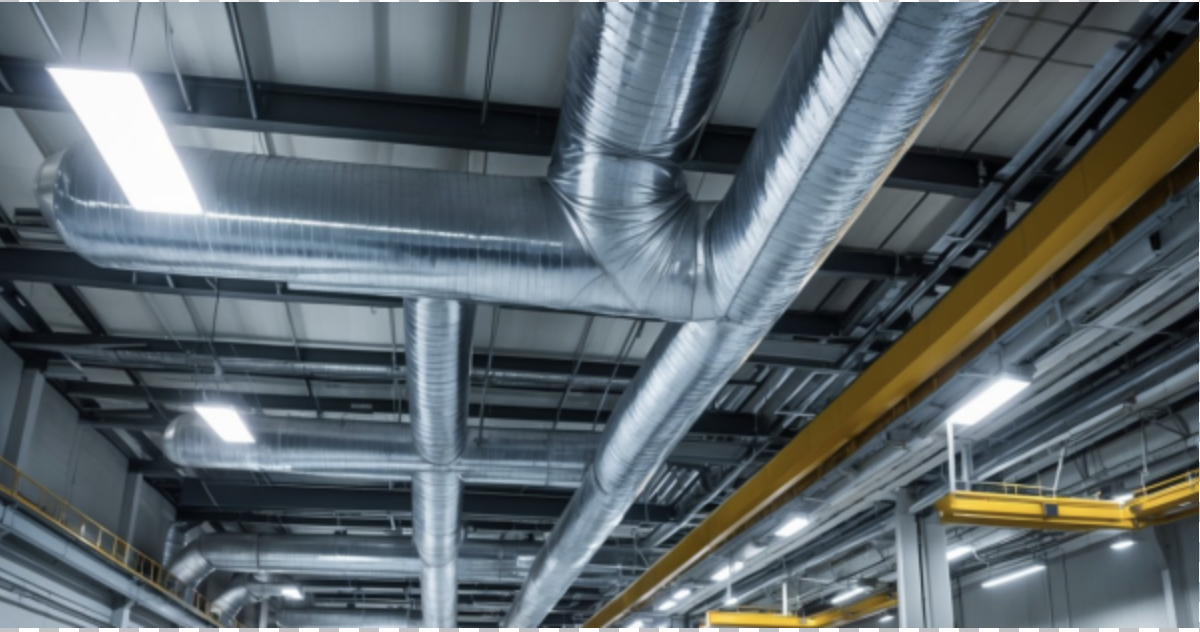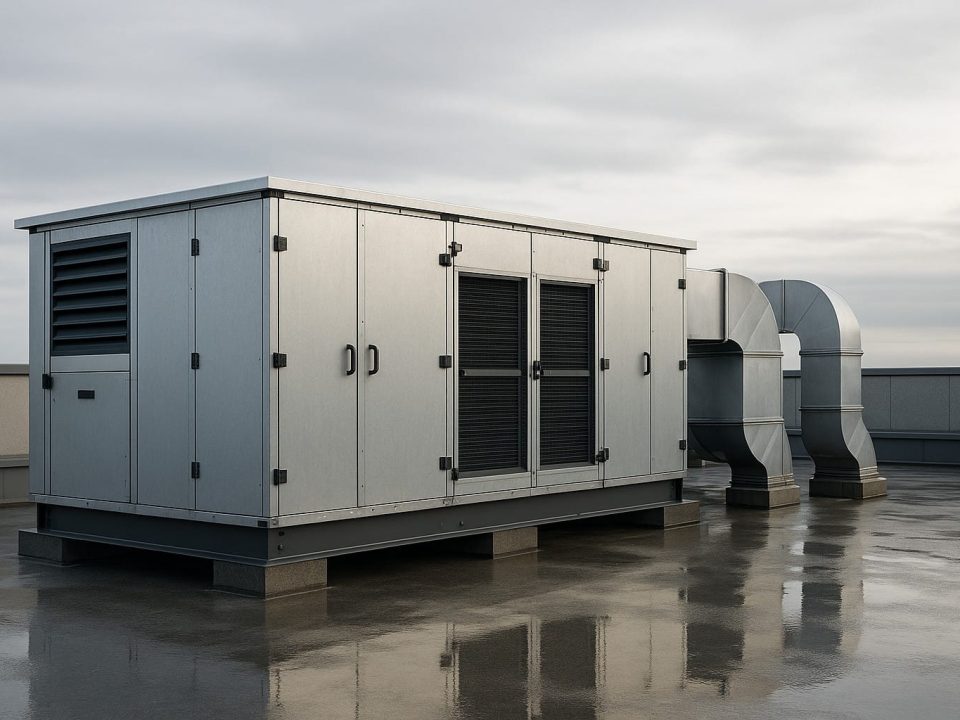
How Commercial Air Conditioning Improves Staff Productivity and Comfort
July 8, 2025
The Ultimate Guide to Commercial Heating Systems: Efficiency, Types & Costs
July 25, 2025Table of Contents
Silica dust is one of the most serious health risks facing factory workers today. Produced during common activities like cutting, grinding or drilling stone-based materials, it can easily linger in the air without proper controls. Prolonged exposure to respirable crystalline silica can lead to serious conditions such as silicosis, COPD, and even lung cancer.
Effective factory ventilation is one of the most reliable defences against this risk. Beyond simply keeping the air moving, a well-designed system captures and removes hazardous particles before they can be inhaled. In this article, we’ll explore why controlling silica dust is critical, and how smart, compliant ventilation can help protect both workers and your business.
What Is Silica Dust?
Silica dust, or respirable crystalline silica (RCS), is a fine airborne particle released when materials containing silica are cut, drilled, crushed, or ground. Examples include concrete, brick, stone, or sand. While the dust itself may not always be visible, its microscopic particles are small enough to be inhaled deep into the lungs, where they can cause lasting damage.
This type of dust is especially common in factories that produce or work with construction materials or ceramics, as well as in glass manufacturing and metal foundries. Even short-term exposure in poorly ventilated environments can lead to long-term health complications. That’s why factory ventilation plays a vital role in removing these airborne particles before they accumulate to dangerous levels.
Health Risks Associated with Silica Exposure
Exposure to silica dust can be potentially life-threatening. When inhaled, the tiny particles penetrate deep into the lungs and can’t be expelled by the body. Over time, this can lead to serious and irreversible respiratory conditions.
The most well-known of these is silicosis: a chronic lung disease that causes scarring and restricts breathing. Prolonged exposure also increases the risk of Chronic Obstructive Pulmonary Disease (COPD) and lung cancer, both of which are recognised by the Health and Safety Executive (HSE) as occupational hazards.
The positive news is that these conditions are preventable. As we’ll discuss below, one of the most effective ways to reduce this risk is by controlling airborne silica with proper factory ventilation.
Key Stats
- Around 600,000 UK workers are exposed to silica dust annually
- Silica is the second-highest cancer risk after asbestos for construction workers
- The UK experiences around 12,000 lung disease deaths annually linked to workplace dust
- About 500 UK construction workers die yearly from silicosis
- Silica is linked to around 4,000 deaths from COPD each year
- Since 2023, the UK has documented its first eight cases of silicosis caused by cutting artificial stone
- Global incidence of silicosis rose 64.6% from 1990 to 2019
- Over 40 million people are exposed to silica dust worldwide
The Role of Factory Ventilation in Silica Dust Control
Effective factory ventilation is essential for managing airborne contaminants like silica dust. It captures and removes harmful particles before they can spread through the workspace and into workers’ lungs. Without it, even routine tasks like cutting, sanding or blasting can quickly create unsafe air quality levels.
There are two main types of ventilation used in industrial settings: Local Exhaust Ventilation (LEV) and General (or Dilution) Ventilation.
- Local Exhaust Ventilation (LEV) is designed to capture dust and fumes directly at the source. These systems typically include hoods, ducts, and filters that remove contaminants before they can disperse into the wider factory environment. LEV is especially effective in high-risk areas such as cutting or grinding stations where silica dust is most concentrated.
- General Ventilation, on the other hand, helps to maintain overall air quality throughout the factory by replacing stale, dust-laden air with fresh, clean air. This can be achieved through natural airflow, mechanical systems, or a combination of both. While general ventilation doesn’t target specific processes, it plays a vital role in reducing background dust levels and supporting thermal comfort and humidity control.
The most robust approach combines both systems, tailored to the unique layout, processes, and risk profile of the facility. Regular maintenance, airflow testing, and system balancing are also critical to ensure continued performance and compliance with health and safety standards.

Legal Requirements and Employer Responsibilities
Employers have a legal duty to protect their workforce from exposure to hazardous substances, including silica dust. In the UK, this falls under the Control of Substances Hazardous to Health (COSHH) Regulations, which require businesses to assess risks and implement adequate control measures.
The Health and Safety Executive (HSE) provides clear guidance on silica dust, setting workplace exposure limits (WELs) and recommending engineering controls such as factory ventilation and Local Exhaust Ventilation (LEV) systems. Failure to comply puts workers at risk, and can lead to enforcement action, including fines, prosecutions, or even shutdowns.
Employers must also ensure that ventilation systems are properly designed, regularly maintained, and thoroughly tested. This includes keeping records of inspections and ensuring systems continue to meet performance standards. By prioritising compliant ventilation solutions, businesses demonstrate their commitment to health, safety, and legal accountability, while avoiding costly consequences down the line.
Benefits of Investing in Professional Factory Ventilation Systems
Installing a well-designed factory ventilation system is a long-term investment in workforce wellbeing, operational efficiency, and business resilience.
The most immediate benefit is improved employee health. Cleaner air reduces the risk of respiratory illness, which leads to lower absenteeism and higher morale. When workers feel safe and supported, productivity and retention rates increase.
Professional ventilation systems also help businesses stay compliant with COSHH and HSE standards, avoiding fines, disruption, or reputational damage. And with smart system design, there are tangible cost savings to be made, from reduced energy consumption to streamlined maintenance and fewer health-related incidents.
Finally, cleaner, better-regulated environments contribute to a safer, more efficient workspace. Machinery performs better in dust-free conditions, and the risk of fire or explosion is significantly reduced, especially in industries handling fine particulates. With expert guidance, ventilation becomes a proactive solution that protects both people and operations.
How Inergy Can Help
At Inergy, we understand that no two factories are the same, and neither are their ventilation needs. With years of experience designing and installing bespoke factory ventilation systems, we help businesses across the UK create safer, cleaner, and more compliant workspaces.
Our approach begins with a full site assessment to identify dust sources, airflow challenges, and regulatory requirements. From there, we design tailored ventilation solutions engineered for maximum efficiency and minimal disruption. This could include LEV systems, general air exchange setups, or a hybrid approach.
Inergy offers full lifecycle support, from commissioning and compliance testing to ongoing maintenance and system optimisation. Whether you’re upgrading an outdated system or building from scratch, we’ll ensure your solution not only meets HSE standards but actively protects your people and productivity every day.

Tackle Silica Dust with Factory Ventilation from Inergy
Silica dust may be invisible, but its impact on worker health and factory safety is all too real. From long-term respiratory illness to regulatory risks, the consequences of poor air quality can be severe. Fortunately, they’re also entirely preventable. Investing in professional factory ventilation isn’t just a precaution; it’s a strategic decision that protects people, operations, and reputation.
With the right system in place, you’ll reduce airborne hazards, improve compliance, and create a more productive working environment. Inergy Group is here to help you get it right with expert advice, bespoke solutions, and ongoing support.
Ready to take control of your factory air quality? Contact Inergy today to schedule a site assessment or speak with one of our ventilation specialists.




